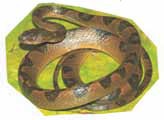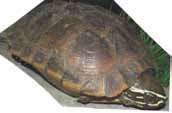
| What is Flavor and Fortune? |
| How do I subscribe? |
| How do I get past issues? |
| How do I advertise? |
| How do I contact the editor? |
Read 13322075 times
Connect me to:
| Home |
| Articles |
| Book reviews |
| Letters to the Editor |
| Newmans News and Notes |
| Recipes |
| Restaurant reviews |
| Article Index (all years, slow) |
| List of Article Years |
| Article Index (2026) |
| Article Index (last 2 years) |
| Things others say |
| Related Links |
| Log In... |
| Authors |
| Categories & Topics |
Snails, Snakes, and Turtles
| by Jacqueline M. Newman |
Unusual Ingredients
Winter Volume: 2017 Issue: 24(4) pages: 33 to 35

Snails live in many countries on land or in the sea. In the family Mollusca, their skin usually feels slippery their flesh does not. Almost all are in the class Gastropoda. One often finds land snails in woodlands, those from the sea in cold or warm water. For the most part, land snakes like fresh water and are most often found near rivers, ponds, lakes, and other waters.
The snail sizes vary considerably, small ones can be as tiny as a periwinkle or as large as some African varieties measuring a foot or more on their flat bottoms that creep along a variety of surfaces. Most snails eat plants, a very small number enjoy some animal flesh, and eat plants, too.
Snails have been people food at least since 50 BCE. The largest among them are probably the whelk and large conch, both endangered, scientists monitoring them as their numbers are dwindling.
On this side of the world they are popular along the East Coast, Gulf Coast, and the Caribbean. They are also popular in high-end restaurants. Most of these are farmed. In many countries harvesting snails from the wild is illegal. In Japan, where they are most popular, about ten thousand tons are harvested annually, most raised and farmed. The French annually eat four times more snails than other population, clearly many imported.
Most snails sold in restaurants come from cold waters, have a long shelf life in the refrigerator, some ten days to two weeks after harvest. Those from warm waters live less than that, some say about half as long.
When purchased, no snail should have an odor, not even a slight trace of ammonia, the most common one as they deteriorate. Their flesh should be white with orange or black flecks if any, and they should pull themselves into their shell when touched on any part of their exposed flesh. Most restaurants purchase theirs frozen from Honduras or Nicaragua, and most are cleaned before they freeze them.
If served in their shells, most shells are not from the snail they are housed in. Those commercially farmed have the shells they come in actually from other snails. They purchase the shells dry with no snail in them. We wonder how, when, and where they crawl into their new homes. One dealer we spoke to said that many of these new snail-homes are probably not real shells at all. Can any reader help us learn more than this, we have not been successful doing so?

Snakes, twice detailed before in this magazine, do find these articles in 2000, and in this year’s Volumes 1 and 2. Check them out on this magazine’s web site; we recommend reading them before finishing this article to learn about these Cantonese delicacies. Not new, they have been loved by these Southern Chinese for more than two thousand years, they eat lots of them and love them in soups and main courses often thickened with water chestnut flour or another starch. They adore snake soup at weddings and other honorific events, and believe all snakes are warming, good for the heart, blood, and energy; and enrich one’s qi.
The Chinese eat all parts of every snake and do not waste a drop of their bile. They skin them as they do eels, and often use the skin after they remove it for ladies shoes and purses. To learn how to do that, check out the picture in Volume 5(4) on page 10. They have a long love-hate relationship with these slithering creatures they call she, and consider them one of five noxious animals as are centipedes, scorpions, lizards, and toads.
I recall events in both Hong Kong and Taiwan when merchants would not sell me a drop of snake bile. I wanted to taste it and learn if it really is as bitter as I had read. Even after I bluffed and told them I was buying it for my husband, they would not sell snake bile to me. To date, I have not managed to purchase any, not even a drop to taste. Not a single vendor would even sell me their meat after these incidents. They were angry, too, because women should not consume snake bile.
Popular in dishes such as Chicken with Five Snakes, Snake and Rainbow Vegetables, Snake Soup, and in other snake dishes, I have since bought snake meat frozen in Chinese supermarkets, but not a single one had its gall bladder, also no bile.

Turtles and tortoises, are popular foods for special occasions. The Chinese believe they are the prototypes of all animals, rulers of the north, animals found in the everyday world that are symbolic of harmony, prosperity, strength, endurance, longevity, and immortality. Their likeness is seen on or near many burial mounds, and they are revered.
Snakes are symbols of family continuation and many memorial burial places of high-ranking officials have carvings of snakes on them. A few are found honoring less lordly folk, and we assume their families did esteem them. In addition, they are seen at festivals, on the icing of sweets baked with lots of sugar as their likeness honors patron deities and represents prosperity, security, and harmony.
Much early Chinese literature writes about eating and loving these animals, particularly giant soft-shelled ones such as the Pelochelys bibroni that live in deep rivers along China’s south coast. They make a lordly gift and are prized when used in turtle soup. Not new to Chinese cuisine, they have been used as such at least since the seventh century BCE.
Their eggs are loved, too, often round and about the same size as are duck eggs. Some are oval and egg-shaped, and after boiling them, we note their whites do not congeal well. When we eat them we also note they are more delicious than most other eggs as they are rich and savory.
Written about in Chu Tzu, a collection of poems in a pharmacopoeia of the 5th century CE, turtle broth is recommended as a tonic. They suggest cooking it with mutton, onions, rice, relish, ginger, and wine. Turtle eggs are considered delicious when pickled in salt, or eaten with pork, melon, wild rice, or pokeweed.
We once read and still have a torn piece of paper saying that in Dongting Lake, a rare turtle known as the ‘Golden One’ was born with a snake-like head, a long neck, a hunch-back, and with golden stripes on its neck and a golden rim on its shell, and with mobile plates on its back. These plates, it said, were capable of crushing insects and snakes, its eggs were said to be more delicious than any other egg. That same torn paper says turtles have incredible stamina, and can go without food for up to five years. We do not know where that scrap came from and do not know if this is true; do you?
One TCM practitioner we queried did say he never saw that particular one and he did not deny the existence of such an animal. He advises that its shell plates, bile, and meat are known by many TCM doctors, they often talk of these things, and these components are used often in traditional Chinese medicinal decoctions. He said their meat is used to treat rheumatism, and noting my skepticism, added, “they surely can do all these things.”
Surprisingly, some turtles have a negative image in some parts of China. Called wang po in Chinese, one chap translated their name as “‘forget eight” and he said they are related to the eight rules of propriety, three of which relate to faithfulness, uprightness, and modesty. He did say he does not know why not everyone likes them. By the way, we never learned what the other five are, and wonder if any reader knows and has more information about these animals? If they do, hope they will advise us. Someone else told us their negative image could be because they have intercourse with snakes. We do wonder where and when this notion came about?
Some Chinese classify all the creatures in this article with the mythical unicorn, the phoenix, and the dragon. We did wonder why, and then learned they think they are super intelligent creatures. A few told us they are associated with the points of the compass and do govern them. However, when we did ask which one is for which compass point, two folk changed the subject. We also asked which animal is for the fourth compass point as we only mentioned three of them, we got different answers from each chap we spoke to. Anyone out there who can clarify this?
In the meantime, enjoy the recipes, they are from a couple of culinary experts, and we are pleased to share them with you. If you know the answers to the above questions, please share. The three recipes below are the only ones these chefs told me.
| Snails in Hot Sauce |
|---|
1 pound frozen snails without their shells
1. Put snails in three cups of water with the salt, bring to
the boil and blanch for a minute, then put them in cold
water and drain. If in their shells, remove and freeze
them for another use.
|
| Snake Stir-Fry |
|---|
1 snake, skin and bones removed and discarded
1. Cut snake meat into thin two-inch long strips, and mix
them with the thick soy.
|
| Turtle Soup With Preserved Vegetables |
|---|
½ pound preserved vegetables, cut in half-inch pieces
1. Soak vegetables in two changes of cold water, each
for ten minutes. Discard each water.
|

Copyright © 1994-2026 by ISACC, all rights reserved
Address
3 Jefferson Ferry Drive
S. Setauket NY 11720